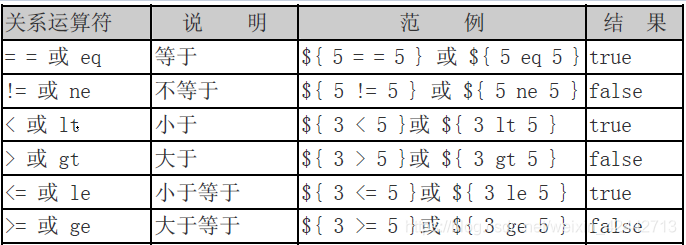javaweb:EL表示式
EL表示式簡介:
EL 全名為Expression Language。

EL主要作用:
獲取資料:
•EL表示式主要用於替換JSP頁面中的指令碼表示式,以從各種型別的web域 中檢索java物件、獲取資料。(某個web域 中的物件,訪問javabean的屬性、訪問list集合、訪問map集合、訪問陣列)
執行運算:
•利用EL表示式可以在JSP頁面中執行一些基本的關係運算、邏輯運算和算術運算,以在JSP頁面中完成一些簡單的邏輯運算。${user==null}
獲取web開發常用物件
•EL 表示式定義了一些隱式物件,利用這些隱式物件,web開發人員可以很輕鬆獲得對
呼叫Java方法
•EL表示式允許使用者開發自定義EL函式,以在JSP頁面中通過EL表示式呼叫Java類的方法。
EL注意事項:
EL表示式是JSP 2.0(JavaEE1.4)規範中的一門技術 。因此,若想正確解析EL表示式,需使用支援Servlet2.4/JSP2.0技術的WEB伺服器。
l注意:有些Tomcat伺服器如不能使用EL表示式
(1)升級成tomcat6
(2)在JSP中加入<%@ page isELIgnored="false" %>
獲取資料(1):
l使用
lEL表示式語句在執行時,會呼叫pageContext.findAttribute方法,用識別符號為關鍵字,分別從page、request、session、application四個域中查詢相應的物件,找到則返回相應物件,找不到則返回”” (注意,不是null,而是空字串)。
l示例:${user}
獲取資料(2):
lEL表示式也可以很輕鬆獲取JavaBean的屬性,或獲取陣列、Collection、Map型別集合的資料,例如:
•${user.address.city}
•${user.list[0]}:訪問有序集合某個位置
•${map.key} : 獲得map集合中指定key的值
l. 和 [ ] 區別
l結合JSTL的foreach標籤,使用EL表示式也可以很輕鬆迭代各種型別的陣列或集合,示例:
•迭代陣列
•迭代collection型別集合
•迭代map型別集合
執行運算:
l語法:
EL語法
${ EL表示式 } : 注意${間不要有空格。
EL存取變數:${ a },取出某一範圍中名稱為a的變數,預設會按page、request、session、application的順序查詢。
<%
request.setAttribute("str", str);
%>
${ str }
${ RequestScope.str }

${運算表示式},EL表示式支援如下運算子:


<%@ page language="java" contentType="text/html; charset=UTF-8"
pageEncoding="UTF-8"%>
<!DOCTYPE html PUBLIC "-//W3C//DTD HTML 4.01 Transitional//EN" "http://www.w3.org/TR/html4/loose.dtd">
<html>
<head>
<meta http-equiv="Content-Type" content="text/html; charset=UTF-8">
<title>el支援運算</title>
</head>
<body>
<%
request.setAttribute("n1", 10);
request.setAttribute("n2", 20);
request.setAttribute("n3", 30);
request.setAttribute("n4", 40);
%>
<h4>EL表示式支援運算</h4>
${ n1 + n2 }
<h4>是否相等</h4>
${ n1 == n2 } ${ n1 eq n2 }
<h4>是否不等</h4>
${ n1 != n2 } ${ n1 ne n2 }
<h4>大於或者小於</h4>
${ n1 > n2 } ${ n1 gt n2 } ${ n1 < n2 } ${ n1 lt n2 }
<h4>大於等於或者小於等於</h4>
${ n1 >= n2 } ${ n1 ge n2 } ${ n1 <= n2 } ${ n1 le n2 }
<h4>與或非</h4>
${ n1 > n2 && n3 > n4 } ${ n1>n2 and n3>n4 }
${ n1 > n2 || n3 > n4 } ${ n1>n2 or n3>n4 }
${ !(n1>n2) } ${ not(n1>n2) }
</body>
</html>
EL表示式保留關鍵字:

l所謂保留字的意思是指變數在命名時,應該避開上述的名字,以免程式編譯時發生錯誤
獲得web開發常用物件:
lEL表示式語言中定義了11個隱含物件,使用這些隱含物件可以很方便地獲取web開發中的一些常見物件,並讀取這些物件的資料。
l語法:${隱式物件名稱} :獲得物件的引用
| 隱含物件名稱 |
描 述 |
| pageContext |
對應於JSP頁面中的pageContext物件(注意:取的是pageContext物件。) |
| pageScope |
代表page域中用於儲存屬性的Map物件 |
| requestScope |
代表request域中用於儲存屬性的Map物件 |
| sessionScope |
代表session域中用於儲存屬性的Map物件 |
| applicationScope |
代表application域中用於儲存屬性的Map物件 |
| 隱含物件名稱 |
描 述 |
| param |
表示一個儲存了所有請求引數的Map物件 |
| paramValues
|
表示一個儲存了所有請求引數的Map物件,它對於某個請求引數,返回的是一個string[] |
| header |
表示一個儲存了所有http請求頭欄位的Map物件 |
| headerValues
|
同上,返回string[]陣列。注意:如果頭裡面有“-” ,例Accept-Encoding,則要headerValues["Accept-Encodings"] |
| cookie |
表示一個儲存了所有cookie的Map物件 |
| initParam |
表示一個儲存了所有web應用初始化引數的map物件 |


測試各個隱式物件
demo1.jsp:
<%@ page language="java" contentType="text/html; charset=UTF-8"
pageEncoding="UTF-8"%>
<!DOCTYPE html PUBLIC "-//W3C//DTD HTML 4.01 Transitional//EN" "http://www.w3.org/TR/html4/loose.dtd">
<html>
<head>
<meta http-equiv="Content-Type" content="text/html; charset=UTF-8">
<title>Insert title here</title>
</head>
<body>
<form action="/day13/jsp/eldemo3.jsp" method="post">
使用者名稱:<input type="text" name="username" /><br/>
<input type="submit" value="提交"/>
</form>
</body>
</html>
demo2.jsp:
<%@ page language="java" contentType="text/html; charset=UTF-8"
pageEncoding="UTF-8"%>
<!DOCTYPE html PUBLIC "-//W3C//DTD HTML 4.01 Transitional//EN" "http://www.w3.org/TR/html4/loose.dtd">
<html>
<head>
<meta http-equiv="Content-Type" content="text/html; charset=UTF-8">
<title>Insert title here</title>
</head>
<body>
<h4>傳統方式</h4>
<%= request.getParameter("username") %>
<h4>使用EL表示式內建物件獲取請求引數</h4>
${ param.username }
${ paramValues.username[0] }
<h4>使用EL表示式的內建物件獲取請求頭的資訊</h4>
${ header.referer }
${ headerValues.referer[0] }
${ header["user-agent"] }
<h4>獲取全域性初始化引數的值</h4>
${ initParam.encoding }
<h4>使用傳統方式獲取cookie中的值</h4>
<%
Cookie [] cookies = request.getCookies();
for(Cookie c : cookies){
if(c.getName().equals("last")){
String value = c.getValue();
%>
<font color="blue"><%= value %></font>
<%
}
}
%>
<h4>使用EL表示式來獲取內容</h4>
${ cookie.last.name } -- ${ cookie.last.value }
<font color="red">${ cookie.last.value }</font>
<form action="">
<input type="text" name="username" value="${ cookie.last.value }" />
</form>
<h4>EL表示式中的pageContext物件</h4>
${ pageContext.request.contextPath }
${ pageContext.request.remoteAddr }
<form action="${ pageContext.request.contextPath }/xxx" method="post">
<input type="text" name="username" />
</form>
</body>
</html>
注意事項
•測試headerValues時,如果頭裡面有“-” ,例Accept-Encoding,則要headerValues[“Accept-Encoding”]
•測試cookie時,例${cookie.key}取的是cookie物件,如訪問cookie的名稱和值,須${cookie.key.name}或${cookie.key.value}

EL表示式獲取集合的值:
el1.jsp
<%@page import="cn.itcast.domain.Person"%>
<%@page import="java.util.HashMap"%>
<%@page import="java.util.Map"%>
<%@page import="java.util.ArrayList"%>
<%@page import="java.util.List"%>
<%@ page language="java" contentType="text/html; charset=UTF-8"
pageEncoding="UTF-8"%>
<!DOCTYPE html PUBLIC "-//W3C//DTD HTML 4.01 Transitional//EN" "http://www.w3.org/TR/html4/loose.dtd">
<html>
<head>
<meta http-equiv="Content-Type" content="text/html; charset=UTF-8">
<title>Insert title here</title>
</head>
<body>
<%
pageContext.setAttribute("username", "美美");
request.setAttribute("username", "張默");
session.setAttribute("username", "烏鴉");
application.setAttribute("username", "李代沫");
%>
<h4>EL獲取域物件中的值</h4>
${ pageScope.username }
${ requestScope.username }
${ sesssionScope.username }
${ applicationScope.username }
<h4>從陣列中取值(把陣列存到域物件中)</h4>
<%
String [] arrs = new String[]{"美美","張默","房祖名"};
// 先把陣列存到域中
pageContext.setAttribute("arrs", arrs);
%>
${ arrs[2] }
<h4>從List集合中取值(域物件中)</h4>
<%
List<String> list = new ArrayList<String>();
list.add("美美");
list.add("張默");
list.add("房祖名");
pageContext.setAttribute("list", list);
%>
${ list[1] }
<h4>從Map集合中取值</h4>
<%
Map<String,String> map = new HashMap<String,String>();
map.put("aaa", "美美");
map.put("bbb", "張默");
map.put("ccc-ddd", "房祖名");
pageContext.setAttribute("map", map);
%>
${ map["ccc-ddd"] }
<h4>從List存入物件集合中取值(域物件中)</h4>
<%
List<Person> ulist = new ArrayList<Person>();
ulist.add(new Person("美美","123"));
ulist.add(new Person("張默","456"));
ulist.add(new Person("祖明","789"));
pageContext.setAttribute("ulist", ulist);
%>
${ ulist[2].username }
</body>
</html>
Person.java:
package cn.itcast.domain;
public class Person {
private String username;
private String password;
public String getUsername() {
return username;
}
public void setUsername(String username) {
this.username = username;
}
public String getPassword() {
return password;
}
public void setPassword(String password) {
this.password = password;
}
public Person(String username, String password) {
super();
this.username = username;
this.password = password;
}
public Person() {
super();
}
public String toString() {
return "Person [username=" + username + ", password=" + password + "]";
}
}
